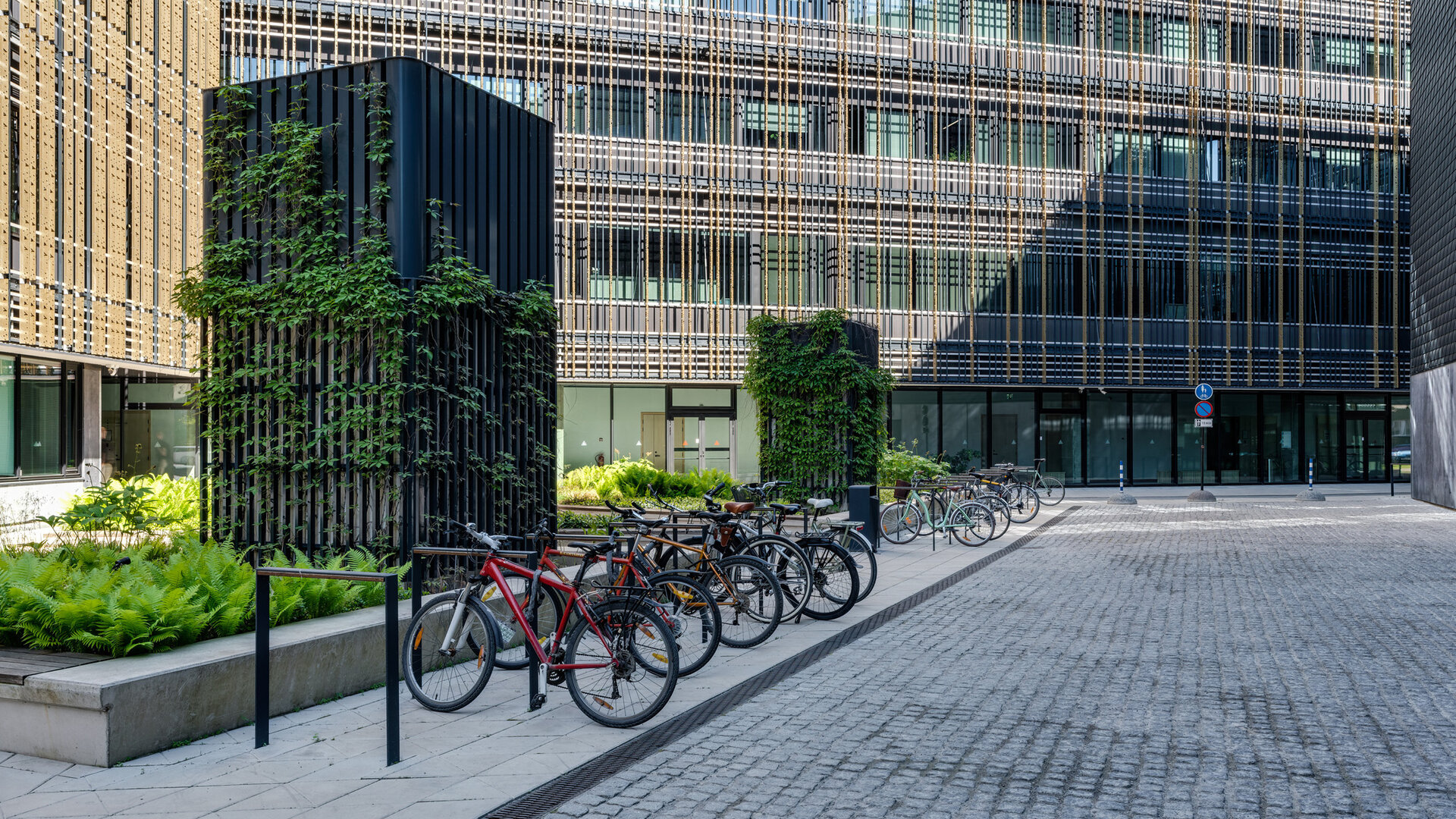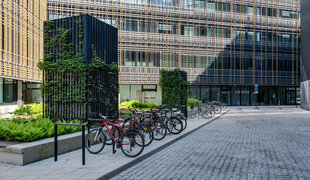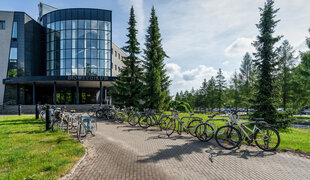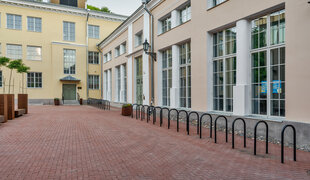Sustainable academic and research buildings
The University of Tartu has an important role to play in shaping the space of Tartu and its college towns, preserving cultural heritage and implementing energy-efficient solutions. The university buildings cover above 300,000 square metres, which is more than 42 football stadiums of built-up area. Around a third of this is valuable cultural heritage. In addition to Tartu, Narva, Pärnu and Viljandi, there are also university buildings in Tõravere, Saaremaa, Ida-Viru County, Tallinn and on the north coast.
In 2022 and 2023, the university invested €5.7 million in energy efficiency, of which €5 million came from the Ministry of Education and Research's smart investments grant. In 2023, work started for a further €2 million, and will be completed in 2024. Read more about the works (in Estonian) completed with the help of the grant.
In 2024 and 2025, the university will continue to reduce the environmental impact of its buildings with the support of the Ministry of Education and Research. The ministry subsidises the university with €2.34 million. The continued support comes on top of the €5 million allocated last year. Read more on the UT website.
As a result of the investments made in recent years, the university's electricity costs have decreased by 12–14% per month.
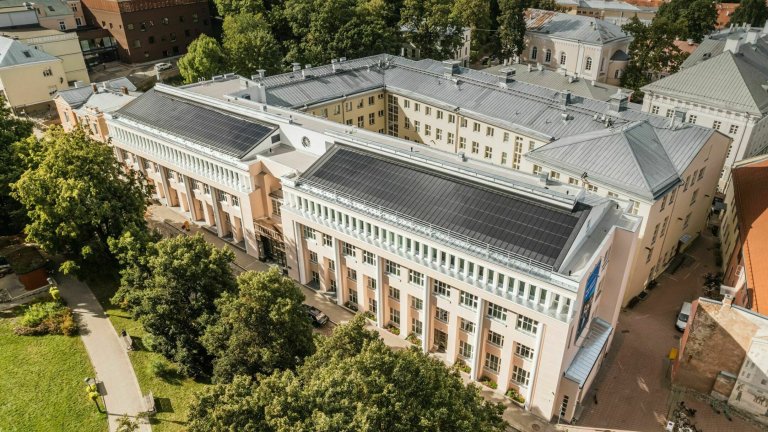
Innovations in recent years
The use of solar energy in university buildings will help reduce greenhouse gas emissions into the atmosphere. Together with storage batteries, this makes the university less sensitive to fluctuations in electricity prices. For example, solar panels were installed on the library and on the buildings at Lossi 3 and Lai 38, more than doubling the university's electricity generation capacity.
A solar park and storage system have been installed in the following buildings:
- Lai 38, Botanical Garden
- Narva mnt 18, Delta Study and Research Building
- W. Struve 1, UT Library
- Ujula 4, sports centre
- Living quarters at Kõiguste field station
A solar park has been installed in the following buildings:
- Liivi 2, Oecologicum
- Narva mnt 20
- Nooruse 7, dormitory
- Lossi 3, an academic building in a heritage conservation area (a solar profile was installed on the roof, read more in the UT magazine article (in Estonian)).
In August 2024, a solar park will be installed on the Chemicum (Ravila 14a), Physicum (W. Ostwald 1) and Ravila 14b buildings.
In 2023, the University of Tartu consumed 17,845,954 kWh of electricity, of which 2.81% was self-generated solar electricity. As of the beginning of June 2024, the university has produced 263,696 kWh of solar electricity. From March 2024, the university only purchases electricity from renewable energy sources. Read more on the UT website.
The advantages of district heating are environmental friendliness, convenience, high security of supply and competitive price. Local wood chips and waste heat are used for district heating in Tartu, which are reliable energy sources. As a result, fossil fuel consumption will decrease and security of supply will increase. Since 2022, the following buildings have switched from gas to district heating:
- Näituse 2, Institute of Psychology
- Näituse 20 ja 13a, School of Law
- Lossi 25, UT Museum
- Ravila 19, Biomedicum
- Ülikooli 20, University Café
- Uppsala 4, 6, 8, and 10 which house the Old Anatomical Theatre and the observatory complex
The district cooling system uses chilled water from the Emajõgi River to lower temperature in buildings during the hot season. This will reduce energy consumption, noise from conventional cooling equipment and the use of fossil fuels. District cooling systems in Tartu have been recognised with the efficient district cooling label. Since 2019, the following buildings have been connected to the district heating system:
- Lossi 3, Institute of Foreign Languages and Cultures
- Jakobi 2, Philosophicum
- Ravila 19, Biomedicum
- Uppsala 10, Old Anatomical Theatre
- Delta buildings
- W. Struve 1, UT Library
- Ujula 4, sports centre
- Liivi 2, Oecologicum
- Ülikooli 18a and Lossi 36, for which a district cooling network has been built.
In recent years, the indoor climate of the following buildings has been significantly improved by replacing their ventilation and heating systems:
- Näituse 2, Institute of Psychology
- Ülikooli 16
- Näituse 20, School of Law
- Ülikooli 18, main building
- Observatooriumi 1, laboratory
- Uppsala 10, Old Anatomical Theatre
- Ravila 14a, Chemicum
- Pärnu College
Modern LED lighting helps save electricity and improve lighting conditions in working and learning environments. For example, in the offices of the Natural History Museum, electricity consumption is more than twice as low after the switch to LED lighting, but light output is much better. Lighting fixtures have been replaced in the following buildings since 2022:
- Vanemuise 46, Natural History Museum
- Lossi 25, UT Museum
- Ujula 4, athletics hall in the sports centre
- Ülikooli 18, main building
- Ülikooli 18a
Setting up automatic control of technical systems provides the ability to monitor and control room air quality, temperature and humidity in real time. The data collected will also be used to set heating intervals in winter and cooling intervals in summer to reduce energy use. For example, the electricity consumption of the building of Viljandi Culture Academy at Posti 1 has been reduced by 40%. Since 2022, automatic control of the technical system has been operating in the following buildings:
- Posti 1, UT Viljandi Culture Academy
- Nooruse 1, Institute of Technology
- Ülikooli 18, main building
- Näituse 2, Institute of Psychology
- Näituse 20, School of Law
- Uppsala 10, Old Anatomical Theatre
For Ülikooli 18a, the system has been designed and construction will start in 2024.
In 2024 and 2025, thermal insulation of windows will be ensured in the following buildings:
- Vanemuise 46, one end wall (heritage windows)
- Ülikooli 18a
In 2024, the central router of the University of Tartu's computer network will be replaced, which interconnects the server networks and firewall equipment of the university buildings in Tartu. The central router consists of two physical devices in a highly manageable configuration. This ensures better resilience and allows software upgrades with shorter interruptions. The new central router would consume more than 1700 W less power per month.
Sustainable mobility in Tartu and college towns
The University of Tartu encourages cycling among its staff and students. In total, there are around 2,400 bike racks outside the university buildings, of which 1,410 are covered. You can get an overview of bike parking in the university's virtual tour by clicking on the bike icon on the building's exterior image. In addition to information on parking options, you can also see photos of all the bike racks.
In 2023–2024, the University of Tartu Mobility Lab in cooperation with the University of Tartu Research Group of Physical Activity for Health carried out a mobility survey to support sustainable mobility at the university. The survey results will provide a basis for formulating mobility-related environmental principles and preparing a mobility plan at the university. Read more about the results of the survey on the UT website (in Estonian).



